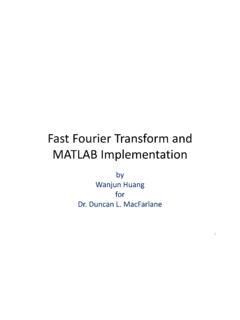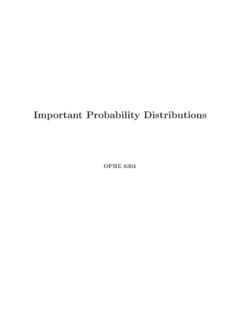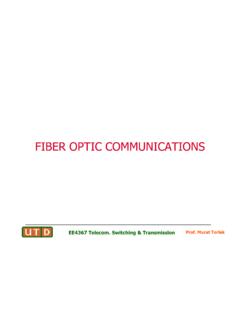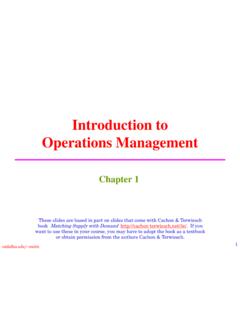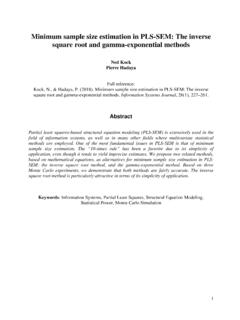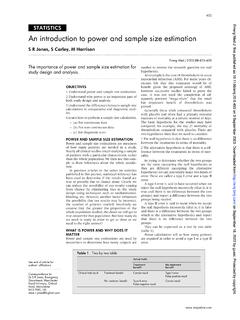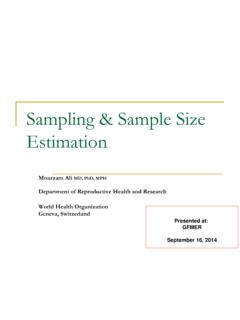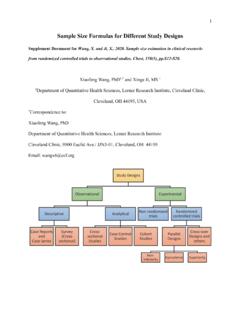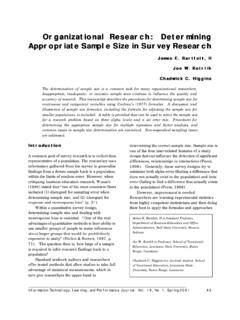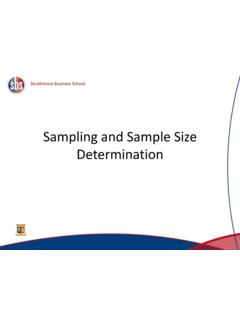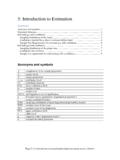Transcription of Introduction to Estimation - University of Texas at Dallas
1 Introduction to EstimationOPRE 6301 Statistical Inference ..Statistical inferenceis the process by which we inferpopulation properties from sample are two types of statistical inference: Estimation Hypotheses TestingThe concepts involved are actually very similar, whichwe will see in due course. Below, we provide a basicintroduction to ..The objective of Estimation is to approximate the value ofa population parameter on the basis of a sample example, the sample mean Xis used to estimate thepopulation mean .There are two types of estimators: Point Estimator Interval Estimator2 Point Estimator.
2 Apoint estimatordraws inferences about a populationby estimating the value of an unknown parameter usinga single value that for a continuous variable, the probability ofassuming any particular value is zero. Hence, we are onlytrying to generate a value that is close to the true estimators typically donotreflect the effects oflarger sample sizes, whileinterval estimatordo ..3 Interval Estimator ..An interval estimator draws inferences about a populationby estimating the value of an unknown parameter usingan interval. Here, we try to construct anintervalthat covers the true population parameter with a an example, suppose we are trying to estimate themean summer income of students.
3 Then, an interval es-timate might say that the (unknown) mean income isbetween $380 and $420 with probability of Estimators ..The desirability of an estimator is judged by its charac-teristics. Three important criteria are: Unbiasedness Consistency EfficiencyDetails ..5 Unbiasedness ..Anunbiased estimatorof a population parameter isan estimator whoseexpected valueis equal to that pa-rameter. Formally, an estimator for parameter is saidto be unbiased if:E( ) = .(1)Example: The sample mean Xis an unbiased estimatorfor the population mean , sinceE( X) = .It is important to realize that other estimators for thepopulation mean exist: maximum value in a sample, min-imum value in a sample, average of the maximum and theminimum values in a sample.
4 Being unbiased is a minimal requirement for an estima-tor. For example, the maximum value in a sample isnotunbiased, and hence should not be used as an estimatorfor .6 Consistency ..An unbiased estimator is said to beconsistentif thedifference between the estimator and the target popula-tion parameter becomes smaller as we increase the samplesize. Formally, an unbiased estimator for parameter issaid to be consistent ifV( ) approaches zero asn .Note that being unbiased is a precondition for an estima-tor to be 1: The variance of the sample mean Xis 2/n,which decreases to zero as we increase the sample , the sample mean is a consistent estimator for.
5 Example 2: The variance of the average oftworandomly-selected values in a sample doesnotdecrease to zero aswe increasen. This variance in fact stays constant!7 Efficiency ..Suppose we are given two unbiased estimators for a pa-rameter. Then, we say that the estimator with a smallervariance is 1: For anormallydistributed population, itcan be shown that the sample median is an unbiased es-timator for . It can also be shown, however, that thesample median has a greater variance than that of thesample mean, for the same sample size . Hence, Xis amore efficient estimator than sample 2: Consider the following estimator.
6 First, arandom portion of a sample is discarded from an origi-nal sample; then, the mean of the retained values in thesample is taken as an estimate for . This estimator is un-biased, but is not as efficient as using intuitive reasoning is that we are not fully utilizingavailable information, and hence the resulting estimatorhas a greater When 2is Known ..Constructing point estimates using the sample mean Xis the best (according to our criteria above) estimatorfor the population mean .Suppose the variance of a population is known. Howdoes one construct anintervalestimate for ?
7 The key idea is that from the central limit theorem, weknow that whennis sufficiently large, the standardizedvariableZ= X / nfollows the standard normal distribution. It is importantto realize that this is true even though we donotknowthe value of . The value of , however, is assumed tobe given (this assumption, which could be unrealistic, willbe relaxed later).9It follows that for a given , we haveP( z /2 n< X +z /2 n)= 1 .Since our unknown is actually , the above can berearranged into:P( X z /2 n< X+z /2 n)= 1 .That is, theprobabilityfor the interval( X z /2 n, X+z /2 n)(2)to contain, or to cover, the unknown population mean is 1 ; and we now have a so-calledconfidence in-tervalfor.
8 Note that the interval estimator (2) is con-structed from X,z /2, , andn, all of which are user-specified value 1 is called theconfidencelevelorcoverage , we have LowerConfidenceLimitUpperConfidenceLimit ConfidenceLevel 2 2 Interpretation:If the interval estimator (2) is usedrepeatedlyto estimatethe mean of a given population, then 100(1 )% ofthe constructed intervals will cover .The often-heard media statement 19 times out of 20 refers to a confidence level of Such a statement isgood, since it emphasizes the fact that we are correct only95% of the : Demand during Lead TimeA computer company delivers computers directly to cus-tomers who order via the Internet.
9 To reduce inven-tory cost, the company employs an inventory model requires information about the mean de-mand during delivery lead time between a centralmanufacturing facility and local experience indicates that lead-time demand is nor-mally distributed with a standard deviation of 75 com-puters per lead time (which is also random).Construct the 95% confidence interval for the mean de-mand. Demand data for a sample of 25 lead-timeperiods are given in the file : Since 1 = , we have = and hence /2 = , for From the givendata file, we obtain the sample mean X= confidence interval is therefore (see (2))( 25, + 25)or simply ( , ).
10 12 Width of Confidence Interval ..Suppose we are told that with 95% confidence that theaverage starting salary of accountants is between $15,000and $100,000. Clearly, this provides little information,despite the high confidence , suppose instead: With 95% confidence that the av-erage starting salary of accountants is between $42,000and $45, second statement of course offers more precise infor-mation. Thus, for a given , the width of a confidenceinterval conveys the extent of precision of the reduce the width, or to increase precision, we can in-crease the sample general, recall that the upper and lower confidencelimits are: X z /2 , the width of the confidence interval is 2z /2 / follows that precision depends on.
